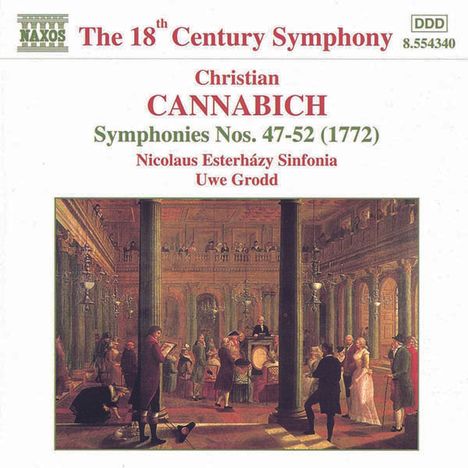Johann Christian Cannabich: Symphonien Nr.47-52 auf CD
Symphonien Nr.47-52
Herkömmliche CD, die mit allen CD-Playern und Computerlaufwerken, aber auch mit den meisten SACD- oder Multiplayern abspielbar ist.
Voraussichtlich wieder lieferbar Ende September 2025
- Künstler:
- Nicolaus Esterhazy Sinfonia, Uwe Grodd
- Label:
- Naxos
- Aufnahmejahr ca.:
- 1998
- Artikelnummer:
- 1574548
- UPC/EAN:
- 0636943434024
- Erscheinungstermin:
- 4.10.1999
- Serie:
- Naxos 18th Century Classics
Die sechs Sinfonien, die Götz 1772 in Mannheim als op. 10 veröffentlichte, entstanden in der Mitte seiner Karriere. In seinem eigenen Katalog der 76 Sinfonien hat Cannabich für diese Werke die Nummern 47-52 vergeben. Obwohl für alle sechs Werke Teilautographe überliefert sind, ist das Veröffentlichungsdatum von Götz das früheste nachweisbare Datum für die Werke. Es ist davon auszugehen, dass sie relativ zeitnah zum Kompositionsdatum erschienen sind und wahrscheinlich als Werkgruppe konzipiert wurden. Die Reihenfolge, in der die Werke in der veröffentlichten Folge erscheinen, stimmt nicht mit Cannabichs eigenem Nummerierungssystem überein: Op. 10 Nr. 1 ist Nr. 51; Op. 10 Nr. 2 ist Nr. 47; Op. 10 Nr. 3 ist Nr. 48; Op. 10 Nr. 4 ist Nr. 49; Op. 10 Nr. 5 ist Nr. 50 und Op. 10 Nr. 6 ist Nr. 52.
Die Sinfonien Opus 10 sind wunderschön komponiert. Die lebhaften Außensätze sind reich an subtilen orchestralen Details, und die schönen Zentralsätze, die stets für Streicher besetzt sind, besitzen eine Haltung und einen kompositorischen Abschluss, von denen sogar ein Mozart lernen könnte. Die düstere Kraft des eröffnenden Allegro non tanto der Sinfonie in d-Moll und der sprunghafte Charme des Finales der Sinfonie in G-Dur enthalten viele stilistische Elemente, die heute als mozartisch gelten. Wenn Mozart seine große technische Virtuosität durch das sorgfältige Studium und die tiefe Wertschätzung der Werke Haydns erlangte, so verdankt sein Orchesterklang und die Sinnlichkeit eines Großteils seines Schreibens den Werken seines Freundes Christian Cannabich.
Product Information
The six symphonies published in Mannheim by Götz in 1772 as Op. 10 were written mid-career. In his own catalogue of the 76 symphonies Cannabich allocated the numbers 47-52 for these works. Although partial autographs survive for all six works, the Götz publication date is the earliest verifiable date for the works. We can assume that they were published relatively close to the date of composition and probably conceived as a set. The order in which the works appear in the published set does not correspond with Cannabich's own numbering system: Op. 10 No. 1 is No. 51; Op. 10 No. 2 is No. 47; Op. 10 No. 3 is No. 48; Op. 10 No. 4 is No. 49; Op. 10 No. 5 is No. 50 and Op. 10 No. 6 is No. 52.
The Opus 10 symphonies are beautifully composed. There is a wealth of subtle orchestral detail in the spirited outer movements and the lovely central movements, invariably scored for strings, possess a poise and compositional finish from which even a Mozart could learn. The sombre power of the opening Allegro non tanto of the Symphony in D minor and the skittish charm of the Finale to the Symphony in G major contain many stylistic elements which are now considered Mozartian. If Mozart acquired his great technical virtuosity through his careful study and profound appreciation of Haydn's works, his orchestral sound and the sensuousness of much of his writing owe much to the works of his friend Christian Cannabich.
-
Tracklisting
-
Mitwirkende
Disk 1 von 1 (CD)
-
1 Symphony No. 49 in F major: I. Allegro spiritoso
-
2 Symphony No. 49 in F major: II. Andante
-
3 Symphony No. 49 In F Major: Iii. Presto Ma Non Troppo
-
4 Symphony No. 50 in D minor, Op. 10, No. 5: I. Allegro non tanto
-
5 Symphony No. 50 in D minor, Op. 10, No. 5: II. Andante con brio
-
6 Symphony No. 50 In D Minor, Op. 10, No. 5: Iii. Presto
-
7 Symphony No. 48 in B flat major: I. Allegro non troppo
-
8 Symphony No. 48 in B flat major: II. Andante
-
9 Symphony No. 48 In B Flat Major: Iii. Tempo Di Menuetto
-
10 Symphony No. 47 in G major: I. Allegro con spirito
-
11 Symphony No. 47 in G major: II. Andante
-
12 Symphony No. 47 In G Major: Iii. Presto
-
13 Symphony No. 51 in D major: I. Allegro
-
14 Symphony No. 51 in D major: II. Andante
-
15 Symphony No. 51 In D Major: Iii. Presto Non Tanto
-
16 Symphony No. 52 in E major: I. Allegro
-
17 Symphony No. 52 in E major: II. Andante
-
18 Symphony No. 52 In E Major: Iii. Allegro Non Tanto
Mehr von Johann Christia...
-
Johann Christian CannabichSymphonien Nr.22 & 57 (C-Dur & Es-Dur)CDAktueller Preis: EUR 19,99
-
Johann Christian CannabichSymphonien Nr.59,63,64,67,68CDAktueller Preis: EUR 14,99
-
Freiburger Barockorchester - Mozarts MannheimCDAktueller Preis: EUR 19,99
-
Neue Düsseldorfer Hofmusik - Cabinetmusik für Carl TheodorSuper Audio CDAktueller Preis: EUR 19,99








